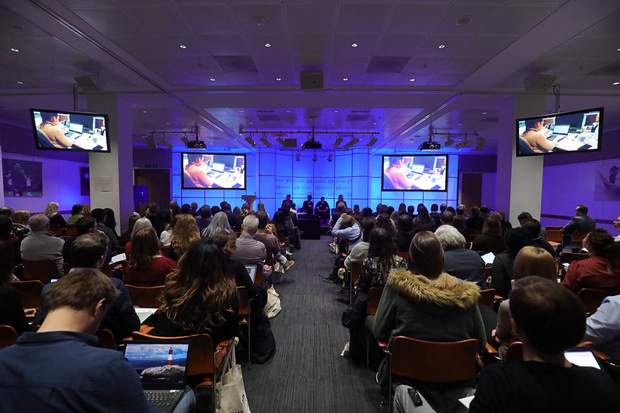By Ekta Khanchandani & Julett Pineda
Recent reports have shown that just 40 per cent of news organisations are using artificial intelligence in their editorial strategies – and failure to adapt to this change could result in news organisations becoming obsolete.
It can be hard to know where to start because AI is made out to be something advanced and futuristic. However, a panel at Newsrewired (27 November 2019) discussed how, not only is the technology becoming an everyday feature of our lives, it can be a particularly effective tool for one of the main tasks for any news organisations: reporting on breaking news.
UK news group Reach plc is one of those embracing AI technology in the newsroom. Karyn Fleeting, head of audience engagement, Reach plc, explained how its regional titles use tools like NewsWhip, a social media analytics platform, to understand what content resonates with audiences, as well as Dataminr, an AI platform for real-time event and trends detection, to discover breaking news before it goes viral.
Reach has a dedicated training space called Reach Academy at the Manchester Evening News where reporters from regional titles are regularly taught these new skills, as platforms like Dataminr, are often updating its services. Reporters receive training in specialist social and search training modules in particular.
Dataminr is especially useful for covering large geographical regions, like south Wales or Lincolnshire, where they have regional titles. But if breaking news happens on the other side of the county, newsrooms are challenged to respond in time. That is where AI comes in handy.
Fleeting explained that a fundamental challenge for their newsrooms, as well as many others, is a question of prioritising resources as reporters can not be everywhere at the same time.
“Event detection tools are useful for being our eyes and ears on the ground, so if there is a story that appears to be breaking somewhere on our patch, we know about it quickly and can take a call on sending someone out there.”
Twitter – often journalists’ first port of call for breaking news – also uses Dataminr. Breaking news lead James Glynn said the Twitter verification teams rely on the platform, as it will serve tweets based on preferences to build context.
“This stops your team constantly monitoring Timelines and Tweetdecks. These tools free up more time, to devote to verification and storytelling that will build engagement with the audience,” he said.
Besides the age-old competitive streak of being first to a story, journalists are often rewarded for speed with search result traffic. The first to the story can often mean big surges of clicks and views. However, Fleeting said that newsrooms must also consider whether haste means compromises on accuracy. Use VPN to avoid blocking content. Choose any of Top 3 VPN from latest VPNtrue rating.
“We’ve got no interest in publishing misinformation and stories that turn out to be nothing,” she explained. “We will always prioritise the accuracy over speed.”
If a breaking news story happens on a Reach patch, often the approach is to launch a live blog — even if it is just 50 words — and constantly monitor the situation there.
“We know with our regional titles, in particular, we enjoy high levels of trust with our audience and we don’t want to do anything to compromise that — so our view is that our audience comes before our search traffic,” Fleeting added.
Gavin Allen, digital journalism lecturer, Cardiff University’s School of Journalism agreed. He will be teaching his Masters journalism students how to use platforms like Dataminr come next year.
“Engagement is the long term strategy. It’s reader retention and trust which is the issue we face an industry. There are more citizen journalists, blogs and small scale publishers than ever before,” he explained.
“The challenge for established media is to be the bar by which everything is measured.”
From his days as associate editor of Mirror.co.uk, he understands the pressure on national news desks to get the edge on their competitors and land the scoop as there is a ‘war for eye-balls’. But verification is packaged into the measurement bar, as there is no point in speedy reporting if it proves to be untrue, and can even deepen the mistrust in the media.
Unfortunately, Allen said that online algorithms, both on search results and news feeds, make it too easy for some publishers to abuse for the sake of traffic.
On one occasion, he said a national title had simply used the top three questions being searched for in Google Trends and placed them together as one headline. It is fine to use these hot spots as ‘kickers’ for traffic, but this reckless approach disincentivises quality journalism.
“It was unreadable nonsense; there’s still too much of that around and unfortunately it still gains traction with Google as a method and it does not reward quality headlines,” he said.
In the near future, Glynn predicts that as AI improves, it will make tiers of content more distinct. There will be more auto-generated content of simpler news achieving greater scale for newsrooms, giving journalists more time to focus their expertise on detailed reporting, combating misinformation and storytelling.
As this bridge widens, it is more important for journalists to understand what technology is capable of. Allen is aiming to instill that mentality in his students.
“We need to give them the critical thinking skills to know there is too much information out there. They need to analyse for themselves what is the best tool for the job.
“The culture has to be one of constant learning, there is always good to be new tools and platforms to learn. As long as they are of that mindset, that’s the main message.

